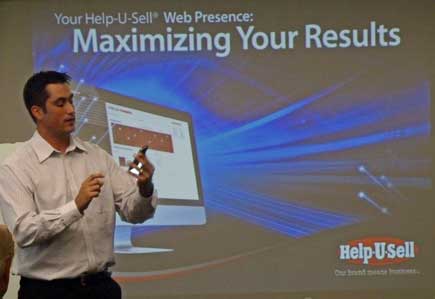Mr. Richard Feder from Fort Lee, New Jersey writes:
‘Dear Set Fee Blog. I have been reading your posts for some time and am convinced that my current real estate company business model – what you call ‘Ordinary’ – is antiquated, out-of-touch with consumers, and, well . . . it sucks. But I don’t know how to go about changing it without firing all of my agents, shutting the doors and starting over. Help me, please. Tell me how to go about abandoning the tired old agent-oriented model and converting to a shiny new consumer-centric, set-fee model.’
Dear Mr. Feder. Thanks for writing and, believe me, you are not alone. I am considering starting a 12 step program for Ordinary Brokers and I’m sure the meetings would fill fast.
But first, let’s understand that the kind of change you’re talking about is HUGE. It’s not just a simple matter of altering how you charge consumers or how you offer your menu of services. Even a well-studied outsider would probably screw it up without expert coaching.
I am a good example. I came to Help-U-Sell in 2004 as an outsider, hired to do a job: upgrade the company’s University. It took three months before I had all of my old paradigms out of the way and could see Help-U-Sell for what it really is: a bold new way to deliver excellent service to consumers while making a healthy profit in real estate. You have to question all of your assumptions, all of your beliefs about how the business works. And you have to change from the core outward. ‘ Sell Fast – Save Thousands’ is just the outward expression of a ton of tweaking behind the scenes. Nonetheless, here is what I suggest:
Start carefully monitoring the lead flow in your office. Where are the leads coming from? What (and who) is generating them? What portion of the incoming leads are coming from company sources as opposed to agent sources? You want to consider this to know how much business your company is likely to do in the event all of your agents pack up and leave; which is a possibility if you go through with the change.
By the way, ‘carefully monitoring the lead flow’ means to monitor it like it’s never been monitored before. You want to get source information on every single inquiry, whether contact information is gotten or not. You want to know why everyone, even the caller who was a nutcase or the one who simply hung up, called your office.
I don’t think you can realistically expect your current staff, and certainly not your current agents to do this. My suggestion: hire someone (or convert your best office admin) to handle ALL phone and Internet inquiries. One person through whom all incoming traffic is routed. This person collects source information, handles the inquiry, collects contact information and then turns the lead over to you for assignment to the appropriate agent. By the way, if yours is a big office, you probably need more than one person doing this important function.
Try to maintain your sense of humor as you review the data your new call coordinators are collecting. You’ll probably discover that many of your agents, in fact, most of them, have been living off leads YOU generated. You’ve been paying them huge splits to generate their own leads, do their own marketing and so on . . . but it has been YOUR marketing, your investment in signs, facilities, web presence, and advertising that has been causing consumers to contact the office. Surprise, surprise! It’s time to wake up now.
As an aside, I once did a modified version of this exercise with an Ordinary broker who had a ‘Top Producer’ who did about 30% of the office’s production. The broker spent most of his days living in fear that the agent would leave. When we did the analysis we discovered that more than half of that agent’s production came from office-generated leads. Then we put a pencil to the company dollar she generated (after the huge split she was paid), deducted a factor for what it cost to produce those company-generated leads and discovered that the broker was probably losing money every time TP closed a deal! He was making more from some of his less productive people. He said goodbye to TP then watched as everybody became more productive and his bottom-line improved.
Start calculating what it actually costs you to market a properly priced listing. Don’t consider what you have to pay a listing agent. We’re only looking at hard costs here: how much marketing, how many days of office operation and so on. Be aware that whatever number you get today may be different tomorrow. Cost to market a listing varies in direct proportion to days on market. If your marketplace slows and DOM goes up, so will your cost to market a listing . . . so take your figure and add a ‘fudge’ factor – say 25%.
Now consider: is there a way to effectively accomplish the successful marketing of a listing without paying an agent 70% or more? This involves carefully examining what a listing agent actually does. We could go through the whole laundry list here and then we could demonstrate how almost all of it could be done much less expensively . . . but instead, let’s just acknowledge a fact you already know to be true in you gut: You’re paying that agent 70% NOT to sell the listing, but to GET the listing. It’s the damndest thing! Today, we pay listing agents at closing not for getting the listing sold – listings, properly priced and plugged into an effective marketing program pretty much sell themselves – but instead as a reward for bringing business into the company. In other words: for getting the listing.
Now your task is becoming clear. You must create marketing and administrative systems for standardizing the marketing of your inventory. You have to take marketing BACK from your agents. You need to design it, orchestrate it, hire the admin staff to get it done. Marketing has to transition from being idiosyncratic – created willy-nilly but a pack of individual agents who have widely different ideas about marketing – to being automatic . . . standardized, monitored, controlled and adjusted by you. In your new universe you’ll be plugging your listings into your already operating marketing system, not designing a whole new marketing program for every listing you take. Its a very big shift.
Then you have to take BACK the ‘getting’ of listings from your agents. You and your team of assistants now need to be in charge of this inventory procurement function. I am aware that the faint of heart, having read this far, are now shutting down their computers. Oppressed by their own paradigms, they cannot envision a world in which listing inventory is secured without agents. But I assure you it can be. It starts with an examination of your seller offer: what do you have to offer that is, far and away, better and different than most of your competitors. If – like most real estate brokers – your offer is identical to every other broker’s, you have a problem. You’re going to have to refine who you are and what you have to offer until you stand out from the crowd and are thus, easy to spot by consumers. Then you must market that offer.
Once your offer to sellers is fine tuned and really different, you will discover that it is much easier to present. Your listing consultation will look something like this:
- Tell me everything I need to know about your move
- This is who we are and how we work
- This is what makes us special and different
- Here is what our past clients say about us
- This is how much we can realistically sell your house for and what you’ll likely net
- Sign here
If you take out all of the fluff and show-biz most listing agents trot out during their presentations, this can be accomplished in, oh, 30 minutes of less. When you have a better deal to present, you don’t need the smoke and mirrors, the fluff and show-biz to get the listing.
Up until now, most of this could be done in stealth mode. You could do your research and preparation without telling your agents. But now that all the ducks are in a row, everything is lined up and ready to go, it’s time to call a special meeting.
Present the state of the company – get right down to profitability. I don’t know what yours is, but if you’re like most Ordinary brokers your company is making less than 5% profit – which is obscene considering the risk owning a real estate company involves. Get their buy-in that that’s a pitiful bottom line for a fine real estate company like yours.
Then present your solution: you are going to become a lead generating machine, which means taking back marketing and investing in it heavily. They will like that. But, you’re also going to take back the listing function. You will no longer need agents to find consumers – you’ll be doing that with marketing. What you will need agents for is handling the buyer leads your marketing and your listings generate. You anticipate that a good buyers agent in this new company you are building should close in the neighborhood of 20 transactions this year – all basically fed to them by the company marketing program. You may now invite all who are not interested in this opportunity (which will be most) to leave. Now, interview the ones who are left. Since you will be shouldering the financial burden for lead generation, who on your remaining staff would you trust with the important task of converting them to sales – for a much more reasonable 50% split.
At the end of the day, your office population may have dropped from, oh, 50 agents and 3 admins/assistants to 5 agents and 4 admins/assistants. You can now begin to look for smaller, less expensive space.
By the way, all through this process, it’s a good idea to contact Ron McCoy at Help-U-Sell for advice and to begin a conversation about becoming part of the family. The Brand will help you through the transition and position you properly for maximum impact in your marketplace.
As you start to walk down this new path, you will begin to feel as if you are waking up from a very long nap. Real estate will look new and it will be exciting again. You will be filled, even driven by a new sense of purpose: the mission. You’ll work harder and have more fun than you have in years. And, in six to nine months, your personal bottom line should be way ahead of where it is today.




 Nick Taylor from Zillow
Nick Taylor from Zillow Tammy Whitehead, Kim Zelena, Stephen Taber
Tammy Whitehead, Kim Zelena, Stephen Taber Robbie Stevens
Robbie Stevens Ron McCoy
Ron McCoy